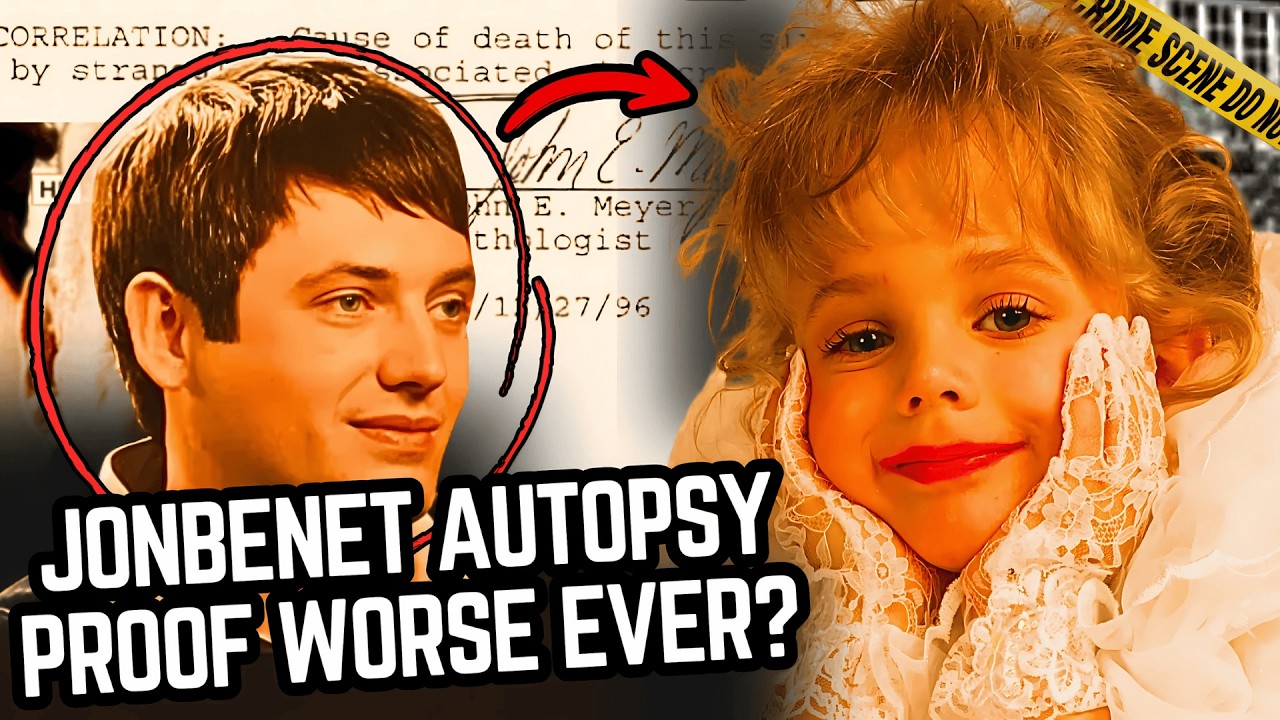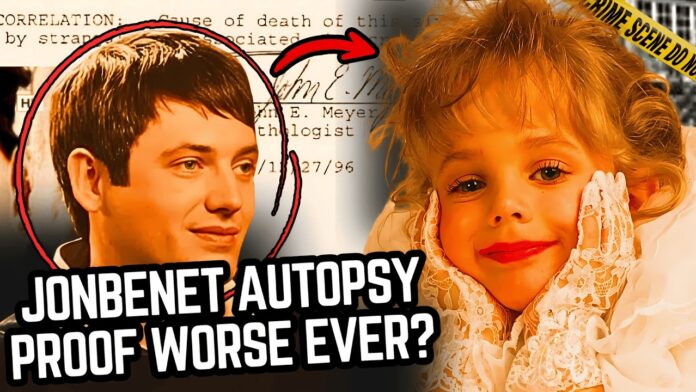What if the knots in a child’s garrote held the killer’s DNA all along—untested for 28 years? 😱
Imagine the horror: a little girl strangled in her own home, a ransom note that mocked investigators, and clues buried in plain sight. For nearly three decades, the JonBenét Ramsey case has haunted America, pointing fingers at family… or a shadowy intruder? Now, shocking new tests on overlooked evidence could finally unmask the monster. But what if the truth shatters everything we thought we knew? Dive deeper into the autopsy secrets they missed—read the full story here: 👇

Nearly three decades after the brutal slaying of 6-year-old beauty pageant star JonBenét Ramsey gripped the nation in a web of suspicion and scandal, a fresh wave of forensic scrutiny is breathing new life into one of America’s most infamous cold cases. As Boulder police quietly dispatch dozens of long-dormant evidence items to state labs for advanced DNA testing, the focus has zeroed in on a chilling detail from the original autopsy: the intricate knots of the garrote used to strangle the child. Experts now believe male DNA—potentially the killer’s—could be lurking in those twists, overlooked amid early investigative blunders that tainted the crime scene and fueled endless tabloid frenzy.
John Ramsey, the victim’s 81-year-old father, sat down for an exclusive interview this month, his voice steady but laced with the quiet fury of a man who’s spent almost 30 years chasing shadows. “That garrote was the tool of her murder, and we’ve known for years there might be DNA in the knots,” Ramsey told reporters, referencing the nylon cord and broken paintbrush handle fashioned into a makeshift noose around his daughter’s neck. “But technology wasn’t there then. Now it is. If they test it right, we could have answers.” The revelation comes on the heels of CrimeCon 2025 in Denver, where Ramsey and his son, John Andrew Ramsey, publicly urged Colorado lawmakers to enact reforms allowing independent labs to tackle stalled cases like this one.
The case, which erupted on December 26, 1996, has long been a lightning rod for controversy. JonBenét, a pint-sized glamour queen with a smile that lit up pageant stages, vanished from her family’s sprawling Boulder home the morning after Christmas. Her mother, Patsy Ramsey, discovered a bizarre two-and-a-half-page ransom note on the kitchen staircase, demanding $118,000—eerily matching John Ramsey’s recent Christmas bonus—for her safe return. “We have your daughter in our possession,” the scrawled message warned in block letters, threatening electrocution or decapitation if cops were called. Patsy dialed 911 anyway at 5:52 a.m., her voice cracking with panic on the tape that’s been dissected by true-crime obsessives ever since.
Hours ticked by in chaos. Friends arrived at the house, trampling potential clues as Boulder police—understaffed and inexperienced with homicides—struggled to secure the 7,000-square-foot Tudor-style mansion. John Ramsey, joined by a family friend, Fleet White, searched the basement around 1 p.m. Behind a closed door in the wine cellar, he found the unimaginable: JonBenét’s lifeless body, wrapped in her favorite white blanket, duct tape over her mouth, and that deadly garrote cinched tight around her neck. She was still clad in her sequined pageant shirt and urine-stained long johns, her hands bound above her head with white cord.
The autopsy, conducted the next day by Boulder County coroner Dr. John Meyer, painted a grim portrait of the final hours. JonBenét’s cause of death: “asphyxia by strangulation associated with craniocerebral trauma.” A massive skull fracture—measuring 8.5 inches long—from a blow to the right side of her head had hemorrhaged into her brain, but it wasn’t immediately fatal. She likely lingered, semi-conscious, as an intruder (or someone inside) fashioned the garrote from household items and tightened it, crushing her larynx and causing petechial hemorrhaging in her eyes. Toxicology showed no drugs in her system, debunking early whispers of sedation.
But the report’s most haunting passages detailed signs of sexual assault. Vaginal abrasions, hyperemia (inflammation from trauma), and traces of blood suggested penetration—possibly with the broken paintbrush handle from the garrote. “The hymen showed no acute injury,” Meyer noted, but deeper exam revealed “a small amount of red blood cells” and “birefringent foreign material” in the vaginal vault, hinting at something inserted forcefully. Under her fingernails—both hands—scrapings yielded epithelial cells and a single drop of unidentified male DNA, later matched to a partial profile on her underwear. That DNA, from an unknown Caucasian male, didn’t belong to John, Patsy, or their 9-year-old son Burke. It was touch DNA, a speck too tiny for 1996 tech to fully profile, but enough to exonerate the family in 2008 when Boulder DA Mary Lacy publicly cleared them.
What investigators missed—or dismissed—for 28 years? Plenty. The autopsy photos, pored over by retired detective Lou Smit (hired by the DA in 1997), revealed faint rectangular marks on JonBenét’s shoulder and arm, consistent with stun gun prongs. Smit, who became a fierce intruder theorist before his 2010 death, argued these were overlooked signs of subdual, not family staging. Fibers on her clothing didn’t match the Ramseys’ wardrobe but hinted at an outsider’s boot or glove. And the garrote’s knots—complex sailor-style loops—were never swabbed deeply enough for DNA. “Back then, they focused on the family,” Smit’s protégé, John Douglas, a former FBI profiler hired by the Ramseys, wrote in his book The Cases That Haunt Us. “The intruder evidence was right there in the autopsy, but tunnel vision blinded them.”
Fast-forward to September 2025: Boulder PD, under Interim Chief Steve Redfearn, has shipped “dozens of items” to the Colorado Bureau of Investigation for genetic genealogy testing—a method blending DNA with public ancestry databases that’s cracked cases like the Golden State Killer. The haul includes retests of old samples (like the garrote cord) and never-before-examined basement artifacts: a suitcase positioned oddly under a broken window (possible escape route), rope from a guest room, and a basement flashlight with no fingerprints. John Andrew Ramsey, JonBenét’s half-brother, confirmed to outlets that some pieces “have never seen a lab.” The department insists it’s “committed to every lead,” refuting claims of stalled progress, but won’t disclose specifics amid the active probe.
John Ramsey, who met with Redfearn in January, calls this the most hopeful he’s felt since Patsy’s 2006 death from ovarian cancer. “Genetic genealogy is the key,” he said in a CNN interview, pushing for a new state law to fast-track such tests in cold cases. At CrimeCon, he recounted the family’s torment: Patsy’s stage-4 cancer recovery just months before, the media circus painting them as pageant-pushers covering a botched cover-up. “We were cleared by DNA in 2008, but the damage lingers,” he said. Burke, now 38 and a software exec, has sued CBS for a 2016 docuseries implying he accidentally killed his sister over a midnight snack—pineapple traces in JonBenét’s stomach that matched a bowl in the kitchen.
Theories abound, from the absurd to the plausible. Early suspects included neighbor Bill McReynolds (whose daughter was abducted years prior) and Michael Helgoth, a mechanic who shot himself months later with a stun gun in his car. John Mark Karr, a teacher obsessed with the case, confessed in 2006—claiming he drugged her—but flunked the DNA test and autopsy debunked sedation. Gary Oliva, a convicted sex offender near the home that night, penned creepy letters: “I love you JonBenét.” His DNA didn’t match, but he had autopsy photos on his phone. The ransom note, penned on Patsy’s notepad with her Sharpie, baffles still—too long, too literate, with movie quotes like “Victory! S.B.T.C.” (Subic Bay Training Center? Saved By The Cross?).
Critics slam the initial probe as a debacle. Only JonBenét’s room was initially taped off; cops let 20+ people—including the Ramseys—roam free, contaminating prints and fibers. No photo log of the body in situ. Handwriting analysis on the note? Inconclusive, thanks to Patsy’s “exemplars” written under duress. A 1999 grand jury voted to indict John and Patsy for child endangerment (not murder), but DA Alex Hunter balked, citing insufficient evidence. By 2010, the case reopened with federal help, but leads dried up.
Now, with Netflix’s 2024 doc Cold Case: Who Killed JonBenét Ramsey? reigniting buzz—alleging a tampered scene and “bogus” note—pressure mounts. Sources tell ABC News “progress is being made,” with experts like Lawrence Kobilinsky affirming: “The DNA screams unidentified male.” Boulder DA Michael Dougherty echoes: “Evidence proves guilt in cold cases—we’ve done it before.”
Yet skeptics linger. Former detective James Kolar, in his 2012 book Foreign Faction, pushes the Burke theory: a 9-year-old lashing out, parents staging the rest. No charges stuck, and DNA contradicts it. Online, X (formerly Twitter) buzzes with wild speculation—a recent post even floated a hoax tying JonBenét to an unrelated missing woman, Erika Kirk, based on age alone. No evidence, just digital fever dreams.
As autumn leaves fall in Boulder, the Ramsey home—now a private residence—stands silent. JonBenét’s grave in Marietta, Georgia, draws quiet pilgrims. John Ramsey vows no rest: “This isn’t about us anymore. It’s about her justice.” With labs humming and databases growing, 2025 could be the year the autopsy’s ghosts finally speak. Or, like so many times before, the knots might stay tangled.
For the Ramseys, the wait is personal. “Patsy would say, ‘God has a plan,'” John reflected. “I pray this is it.”
